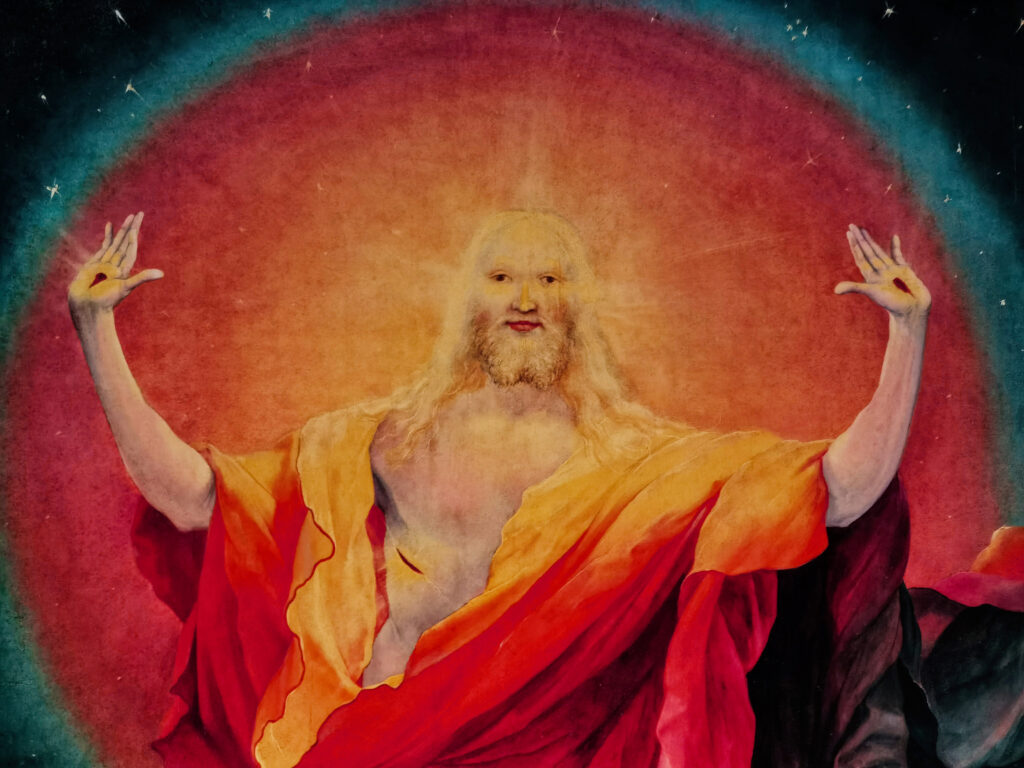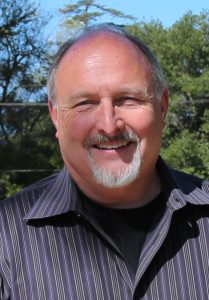Rev. Jim Lawrence

Image: The Isenheim Altar Piece by Matthias Grunewald, 1512, currently at Unterlinden Museum in Colmar, France
After the Sabbath, as the first day of the week was dawning, Mary Magdalene and the other Mary went to see the tomb. And suddenly there was a great earthquake, for an angel of the Lord, descending from heaven, came and rolled back the stone and sat on it. His appearance was like lightning and his clothing white as snow. For fear of him the guards shook and became like dead men. But the angel said to the women, “Do not be afraid, for I know that you are looking for Jesus who was crucified. He is not here, for he has been raised, as he said. Come, see the place where he lay. Then go quickly and tell his disciples, ‘He has been raised from the dead, and indeed he is going ahead of you to Galilee; there you will see him.’ This is my message for you.” So they left the tomb quickly with fear and great joy and ran to tell his disciples. Suddenly Jesus met them and said, “Greetings!” And they came to him, took hold of his feet, and worshiped him. Then Jesus said to them, “Do not be afraid; go and tell my brothers and sisters to go to Galilee; there they will see me.” -Matthew 28:1010 (1)
On Easter Morning, we read a report of second-hand testimony regarding alleged evidence found at a probable crime scene. We heard testimony relevant to a writ of habeas corpus—legal Latin for “you have the body.” Who had the body? Where was the deceased? The testimony claims that in addition to the Roman guards, a strange character was found there, described as an angel. But the deceased whose tomb had been under guard himself was not present. The testimony then. proceeds to the rather astonishing claim that the deceased subsequently was subsequently sighted—but alive and not dead. Subsequently there would be more sightings of the one who had been witnessed as executed, but who the witnesses claimed was appearing in a non-physical body.
If we were starting at square one, there would be an awful lot of careful forensic work that would need to be done: a crime scene to be meticulously examined and documented; material witnesses to be questioned carefully; timelines to be carefully constructed. But we’re not starting at square one. We have all heard this testimony before so often that it is hard to even pay attention to it because it’s the most famous testimony in the history of the world.
We hear it second-hand, as I called it, because the form in which it exists now in our world is a community interpretation written several decades after the incident in question allegedly occurred in what we now call the first century of the common era. And calling it the first century itself refers to this testimony because the calendar system we use is based on when the deceased in this testimony allegedly lived and died—and maybe then lived again—because if truth be told, present-tense testimonies of actual experiences with the alleged deceased has never stopped. But the point I wish to make is that the testimony we heard today is primarily about the illusory nature of death, that there’s no such thing as real death, that what looks like death in this world is only a gateway to another life. Eternal life it has been called, in fact. That is the testimony.
But is it true? There’s a lot of ongoing disagreement about this testimony. Some say they don’t care and don’t believe it has a consequence for what they’re going to do this afternoon. And the question should be asked: do we need to believe in an afterlife to live a good life? No, we don’t. It is not only possible to live ethically, honorably, and courageously with the belief that it is all over when the heart stops pumping. A great many people live very good lives without any believing in anything beyond physical life. And does believing in the afterlife automatically render a person more authentically spiritual? No, it clearly does not. A great many religionists who claim belief in an afterlife commit behaviors and display attitudes that call their spiritual integrity into question.
Well, then, does that mean the question of our soul’s destiny isn’t worth our time and energy—that the testimony is not relevant? I think it is still a very important matter to examine the testimony we have heard today at least in this room because it is no overstatement to say that Swedenborg wrote more about the question of the soul’s destiny, about immortality, and about the afterlife than any other theologian in the history of Christianity.
A great turning point came in 1734 for Swedenborg while in Germany preoccupied with the task of publishing what would become his best-known science work, First Principles of Natural Things, usually just called The Principia. Already Europe’s leading mineralogist, the Principia was about to gain for him a widespread reputation as one of the most important up-and-coming natural philosophers. We know from his travel diary that while there in Germany publishing this science book he was momentously affected by the widespread agnosticism and atheism he found among the intelligentsia, which he deduced could be blamed on the lack of adequate proof of the soul’s immortality.
Never just a dabbler, Swedenborg spent the next seven years attempting to produce medical evidence of the soul’s existence within the physical body. His anatomical research especially on the brain led to some very significant historical discoveries, such as being the first to deduce that different parts of the brain perform specific functions (what’s now called brain location theory). He was also the first to correctly deduce that the brain undulates inside the skull in concert with, not with the heartbeat, which had been the conventional position, but with the lungs. In a recent book called Brain, Vision, Memory: Tales in the History of Neuroscience, Princeton University scholar Charles Gross portrays Swedenborg as an unbelievably prescient intellect working in neuroscience 250 years ahead of his time.
But Swedenborg wasn’t able to prove the testimony of the women at the tomb in quite the fashion he was after. Something else unfolded. He began having experiences in both his dream states and in his lucid meditative concentration states that seemed to open new inner planes within his mind. After several years of this, he believed he was crossing over into real spiritual dimensions while in a completely lucid state, a capacity he retained for the rest of his life. And in this dimension of laboratory research, if you will, he left a lot of his findings—his own, testimony, if you will, primarily in a book whose Latin title is Heaven and Its Wonders and Hell from Things Heard and Seen, usually just called Heaven and Hell, which is by a very large factor his bestseller commanding a long reach into cultural history on the question of immortality. Eric Leigh Schmidt of Harvard University writes, “Archival records reveal that by the 1820s Swedenborg’s Heaven and Hell rivaled in sales the most popular novels by James Fenimore Cooper and Sir Walter Scott.”
Swedenborg presents what was then an entirely new idea about the soul’s survival of physical death than had been believed in the dominant religions of that day: ideas of purgatory, ideas of a shadowy realm called Sheol, ideas of lying dormant in unconscious state until the prophesied Second Coming, as well as ideas of atheism and mere physicalism suggesting no possible continuity of any kind. Swedenborg explains that at physical death the soul awakens right away—immediately—into an alert and very real spiritual existence.
H.W. Janson at New York University, after an extensive study of cemetery art in the 19th century, concludes that Swedenborg’s popular presentation of what life after death is like became the most common spiritual belief of those who believed in an afterlife. You find a dramatic rise in gravesites adorned with images of the beloved awake already in heaven. Even still today, the Gallup Poll people do an annual survey on the afterlife question with about three-fourths routinely saying they think there is probably life after death and that it begins immediately at physical death.
So, in this respect, Swedenborg’s testimony has been quite significant. Yet, it is probably fair to say that in the natural science world there has always existed a great amount of cultural skepticism. NPR religion correspondent Barbara Bradley Hagerty got very curious about that—why scientists seem afraid of exploring near-death studies with the enormous mountain of testimonies that align with the testimony we heard today. Her book Fingerprints of God: the Search for the Science of Spirituality tackles this question about evidence of personality or soul survival from bodily death from the point of view of a secular journalist trying to do justice to the evidence.
She attended conferences at Oxford and the University of Chicago; she read research; she met with countless writers and thinkers associated with the questions. And she concluded that science isn’t following its own standards when it comes to questions such as the soul’s ability to exist apart from the body. The science community in general is derelict in its unwillingness to confront evidence and is not following its own rules of engagement on this particular question. She claims she looked at the masses of evidence and separated out what she regarded as reasonably hard data that a self-respecting scientist should want to explore further. That data is specifically the testimony of now tens of thousands who have no common denominator among them—a truly a randomized batch of source testimony from all walks of life, from all classes and religious backgrounds, including atheists, who claim lucid experiences when at the clinical point of death, completely blacked out who could describe later in vivid detail what went on around them as they hovered outside their physical body—and then here’s the clincher that makes the data relatively hard—they could provide details corroborated by others that were happening in places outside the room in which their body was lying. That’s the hardest data: seeing corroborated real things at a physical distance from the place of clinical brief death. The formerly agnostic Barbara Bradley Hegarty says her research caused her to change her mind about the big questions. She no longer feels agnosticism is a position she can inhabit with integrity because the evidence points to a more-than-physical journey for who we are to become.
There’s a lot of testimony still happening all around us, beloved, but the deep testimony is about love. An incredible state of love is what most near-death experiencers report encountering. Love is the purpose of living in the first place. Love is the “something more” than physicality. Love is the only real takeaway about being here. Love is and was always the message of Jesus: love others as yourself and you find your real self and in so doing you find God. The testimony is that we are designed to live only spiritual bodies in dynamic communities of love. That’s what the truest forensic evidence says is real.
Case solved.
(1) New Revised Standard Version, Updated Edition. Copyright © 2021 National Council of Churches of Christ in the United States of America. Used by permission. All rights reserved worldwide.

Rev. Dr. James F. Lawrence has been an ordained minister in the Swedenborgian Church of North America for several decades, and has served in a variety of settings and ministries. He currently serves as president of the denomination, after many years as dean of the Center for Swedenborgian Studies at the Graduate Theological Union in Berkeley, CA. Jim lives in Oakland with his wife and dog.